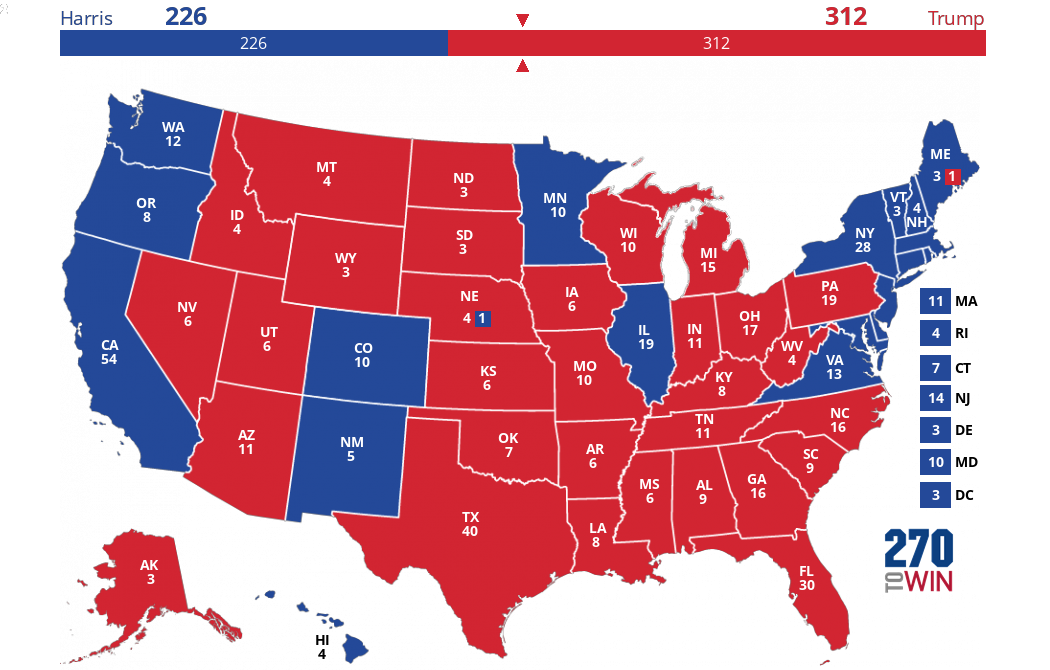Maine
Maine entered the Union in March 1820 as part of the Missouri Compromise. No state outside the original 13 colonies has started with more electoral votes – it had nine in the 1820 election. By the mid-19th century, Maine began losing electoral votes, and has had four since the 1964 election. Primarily Republican from the Civil War (going “blue” only in 1912, 1964, and 1968) through the 1980s, Maine has voted Democratic in the last nine elections. In 2024, Kamala Harris won by 7% over Donald Trump.
Maine has been a tale of two states in the last three elections, with the Democratic nominee winning the 1st congressional district and Trump winning the more rural 2nd district. This is significant in that Maine is one of only two states -along with Nebraska- that do not use a winner-take-all electoral vote allocation. Here, the winner of the statewide popular vote gets two electoral votes, while one is assigned to the winner of each district. As a result, Trump won one of the state's four electoral votes each time he was on the ballot.
ELECTORAL VOTES
42024 ELECTION
Final Consensus Forecast
Safe Harris
Likely Trump
Statewide (larger gauge) is two electoral votes; each district is one.
2024 Maine PollsRecent Presidential Elections
| 2024 |
|
|||
| 2020 |
|
|||
| 2016 |
|
|||
| 2012 |
|
|||
| 2008 |
|
|||
| 2004 |
|
|||
| 2000 |
|
Presidential Voting History
State voted with the overall winning candidate
Electoral College Votes
Colored bars represent electoral votes by party. Tap or hover to see names.
U.S. Senate Voting History
| Class† | 1988 | 1990 | 1992 | 1994 | 1996 | 1998 | 2000 | 2002 | 2004 | 2006 | 2008 | 2010 | 2012 | 2014 | 2016 | 2018 | 2020 | 2022 | 2024 |
|---|---|---|---|---|---|---|---|---|---|---|---|---|---|---|---|---|---|---|---|
| 1 |
D
|
R
|
R
|
R
|
I
|
I
|
I
|
||||||||||||
| 2 |
R
|
R
|
R
|
R
|
R
|
R
|
|||||||||||||
| 3 |
Data: MIT Election Data and Science Lab / Harvard Dataverse through 2018; 270toWin research. These are general election results for the years listed. Special elections, if any, are excluded.
† There are three classes of Senators; one is up for election every second year. Each state has one Senator in two of the three classes.
U.S. House Voting History
| District | 1988 | 1990 | 1992 | 1994 | 1996 | 1998 | 2000 | 2002 | 2004 | 2006 | 2008 | 2010 | 2012 | 2014 | 2016 | 2018 | 2020 | 2022 | 2024 |
|---|---|---|---|---|---|---|---|---|---|---|---|---|---|---|---|---|---|---|---|
| 1 |
D
|
D
|
D
|
R
|
D
|
D
|
D
|
D
|
D
|
D
|
D
|
D
|
D
|
D
|
D
|
D
|
D
|
D
|
D
|
| 2 |
R
|
R
|
R
|
D
|
D
|
D
|
D
|
D
|
D
|
D
|
D
|
D
|
D
|
R
|
R
|
D
|
D
|
D
|
D
|
Data: The Princeton Gerrymandering Project through 2018; 270toWin research. These are general election results for the years listed. Special elections, if any, are excluded.
Vertical lines before 1992, 2002, 2012, and 2022 show Census-related redistricting breakpoints. Geographic borders associated with each district number are likely to have changed.
The state had an additional redistricting before 1994.
Governor Voting History
Data: Wikipedia through 2018; 270toWin research. These are general election results for the years listed. Special elections, if any, are excluded.

